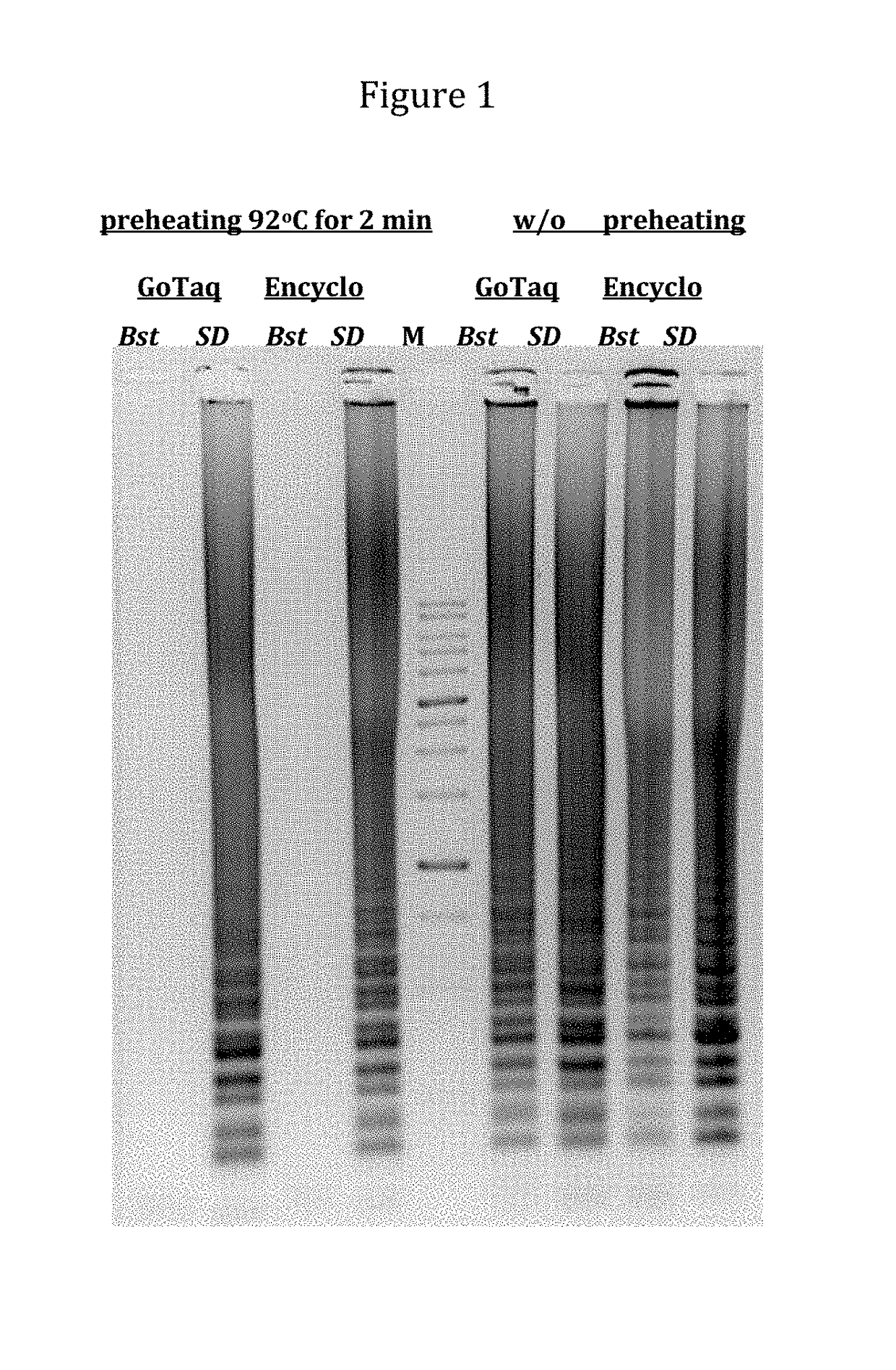DNA polymerases
a polymerase and polymer technology, applied in the field of dna polymerases, can solve the problems of increasing the sensitivity of isothermal dna amplification many times
- Summary
- Abstract
- Description
- Claims
- Application Information
AI Technical Summary
Benefits of technology
Problems solved by technology
Method used
Image
Examples
example 1
Preparation of Chimeric Thermostable Enzyme Using an Expression Vector (Plasmid pTTQ-SD)
[0148]E. coli JM 109 cells were transformed with the plasmid pTTQ-SD according to the method of Dower et al. [1988, Nucl. Acid. Res., V. 16, P. 6127]. The transformed cells were grown to an optical density of A.600=0.3 in 7 L of LB medium containing ampicillin (150 mkg / ml) at 37° C. Expression of the chimeric gene encoding the chimeric polymerase was induced by IPTG (1 mM). The cells were further incubated for 10-12 h at 37° C. Cells were harvested by centrifugation.
[0149]The cells (35 g) were suspended in 70 ml of buffer A (20 mM K-phosphate pH 7.0, 2 mM DTT, 0.5 mM EDTA) containing 0.2M NaCl and 0.1 mM PMSF. The cellular walls were disrupted with an ultrasonic disintegrator (MSE, 150 wt) at maximum amplitude for 15 minutes (30 pulses, each for 30 sec) and with cooling on ice. The suspension was then centrifuged at 40,000 g, the pellet discarded, and 5% polyethylenimine was added to the supernat...
example 2
Comparison of Strand Displacement Activity and Thermostability of SD DNA Polymerase with Bst Large Fragment DNA Polymerase in LAMP Reaction
[0156]Displacement activity and thermostability of SD and Bst DNA polymerase were compared in LAMP reaction.
[0157]LAMP amplification was performed with control template DNA and primers for Group B Streptococcus (GBS) from Meridian Bioscience Inc. (http: / / www.meridianbioscience.com)
[0158]SD and Bst DNA polymerase (NEB) were compared in two reactions buffers: GoTaq buffer (Promega) and Encyclo (Evrogen, www.evrogen.com). Reaction mixtures (50 μl) contained: 50 units of DNA polymerase (SD or Bst), 3.5 mM MgCl2, 0.5 mM dNTP (each), 2 μl GBS control template DNA, and GBS primers: F3T3—0.2 μM, B3—0.2 μM, FIP—0.8 μM, BIP—0.8 μM, FL—0.8 μM, BL—0.8 μM.
[0159]LAMP reactions were performed at 63° C. for 45 min, with or without initial preheating at 92° C. for 2 min.
[0160]The results are shown in FIG. 1, and indicate that the mutant enzyme of the invention (S...
example 3
Comparison of SD DNA Polymerase with Taq DNA Polymerase in Long PCR
[0161]Example 3 illustrates a high efficiency of SD polymerase in PCR amplification. SD polymerase was compared with Taq polymerases from different suppliers like GoTaq polymerase and GoTaq buffer from Promega; MyTaq polymerase and MyTaq buffer from Bioline; and Taq polymerase and Encyclo buffer from Evrogen
[0162]An 8 kb fragment of λ DNA was amplified with 2.5, 5, 10 and 15 units of SD or Taq DNA polymerase. Reaction mixture (50 μl) contained: 5 ng λ DNA as template, 0.25 mM dNTP (each), 10 pmol (0.2 μM) of each primer, 1×PCR buffer, and 3 mM MgCl2.
[0163]PCR was carried out for 25 cycles: preheating for 2 min at 92° C.; cycling for 30 sec at 92° C., 30 sec at 60° C. and 2 min 40 sec (20 sec / kb) at 68° C.
[0164]FIG. 2 demonstrates that SD polymerase provides much higher efficiency of PCR then Taq. This result can be explained by displacement activity of SD polymerase, which solves problems with secondary structures of...
PUM
| Property | Measurement | Unit |
|---|---|---|
| temperature | aaaaa | aaaaa |
| temperature | aaaaa | aaaaa |
| temperature | aaaaa | aaaaa |
Abstract
Description
Claims
Application Information
 Login to View More
Login to View More - R&D
- Intellectual Property
- Life Sciences
- Materials
- Tech Scout
- Unparalleled Data Quality
- Higher Quality Content
- 60% Fewer Hallucinations
Browse by: Latest US Patents, China's latest patents, Technical Efficacy Thesaurus, Application Domain, Technology Topic, Popular Technical Reports.
© 2025 PatSnap. All rights reserved.Legal|Privacy policy|Modern Slavery Act Transparency Statement|Sitemap|About US| Contact US: help@patsnap.com



